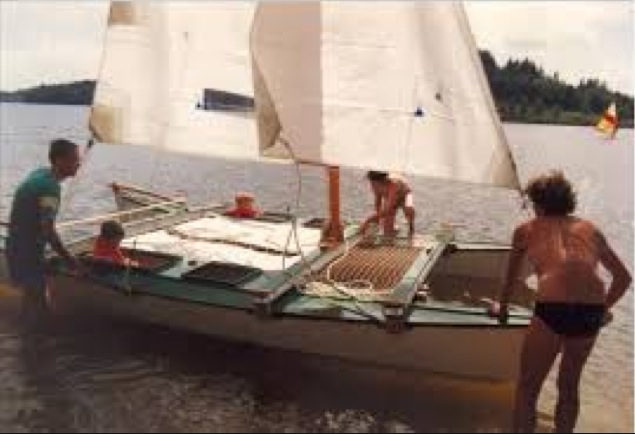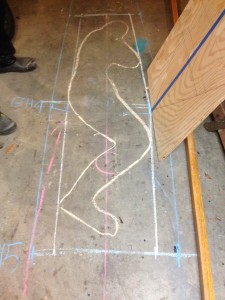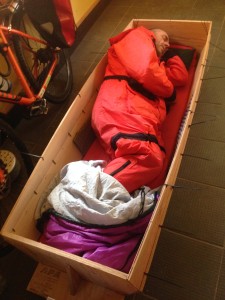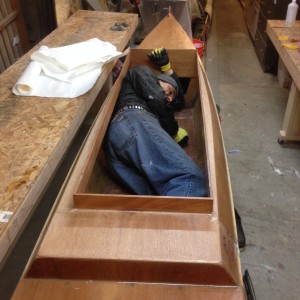On a fateful “Tiki Tuesday” — September 23, 2015 — we decided to take the plunge and enter the Race to Alaska. What a great chance to challenge ourselves in some of the most beautiful seascapes known to sailors! Add the intrigue of finding a design that would be optimal for human and/or wind power in the complex marine environment of the British Columbian coast, and we were hooked. Plus, the process of getting ready to race would definitely get us both more physically fit! Maybe we would get really hardened by the training and end up reversing the feats of The Sea Runners — those hearty Scandinavian canoeists who made it from Baranof Island to Astoria back in the mid-19th-century?!
For the first week we thought a lot about whether it should or could be done in a Hobie 16′ or 18′. We were pretty inspired by Matt Sornson’s video about Minor Threat — their 2013 bid to win the Everglades Challenge by sailing and paddling a Hobie 16′ — especially the part where Sailor Jerry boosts morale (3:02).
We tried sailing a Hobie 16′ out at Sail Sandpoint and quickly had a lot of questions:
- Where are we going to put 10~days worth of stuff (gear, food, water)?!
- Could we really take turns sleeping in some sort of “salmon roll” on deck, or would we need to stop to sleep?
- How wet do you want to be, and for how long?
- What are the risks of capsizing [multiple times?] on the outer coast of British Columbia (vs in the Gulf of Mexico)?
So we dried off and thought about what fundamental goals we had for our R2AK boat. We settled in on 2 key ideas:
- Play to our strengths in building and sailing Wharrams. Thomas wrote at the time: “We are experienced Wharram sailers and should not discount the years of experience we have building and sailing them. We know how well they move and how well they keep their crew. With a little Nielsen project management we will have a well built JWD H17 built in months. Plus I don’t see them as slugs. I think the performance will impress.” And a final motivation sealed the deal: James is in his 90’s and deserves a little more glory before he sails off into the sunset. How cool would it be to win it in a Wharram?!
- Just keep swimming. We both agreed with some of the R2AK introductory panel members who asserted that the winning boat will be the one that keeps moving — both in calm and windy weather. [See 0:50 in the video below… “The boat must look after the crew so they do not have to go ashore. If you can keep one person resting and the other working efficiently, the boat won’t be the fastest, but it will get there first.”] The penultimate speaker reiterated this by saying (at 5:54) he would want to “keep the crew on the boat and keep the boat going all the time.”
This led us down to the UW/WAC yard to visit the Tiki 21′ (Scott’s first Wharram) where we considered whether we could reduce its weight and windage sufficiently by replacing the rigid cockpit platform with a net like Rory did on Cooking Fat, and maybe by cutting its cabins off flush with the decks. Even with such changes, though, we realized it would a big boat for 2 and would still weigh a few hundred kilos unloaded. Could a different Wharram offer just enough shelter for a two-person crew and be much less massive, enabling meaningful movement by a single person?
Then we saw this photo of a Wharram Hitia 14 which weighs in (unloaded) at only 86 kilos.

It has awesome sailing speed and displacement, but looks just about as wet and unaccommodating as the Hobie 16′.
At last, we learned that the Hitia 17′ is plenty fast (15 knots, or 28 km/hr, steady on a reach in SF Bay) and has little holds or lazarettes in each hull. Most people use these holds for storage and sit on top of their hatch covers while sailing, but others were innovators and got down inside the holds themselves:

This helped us realize that the bulkheads forward and abaft of these holds were just about as far apart as we are tall. Perhaps with some modification of the central bulkhead (#4), the Hitia 17 could accommodate a sleeping human?
And thus, the dream of Manu-o-Ku was born…




